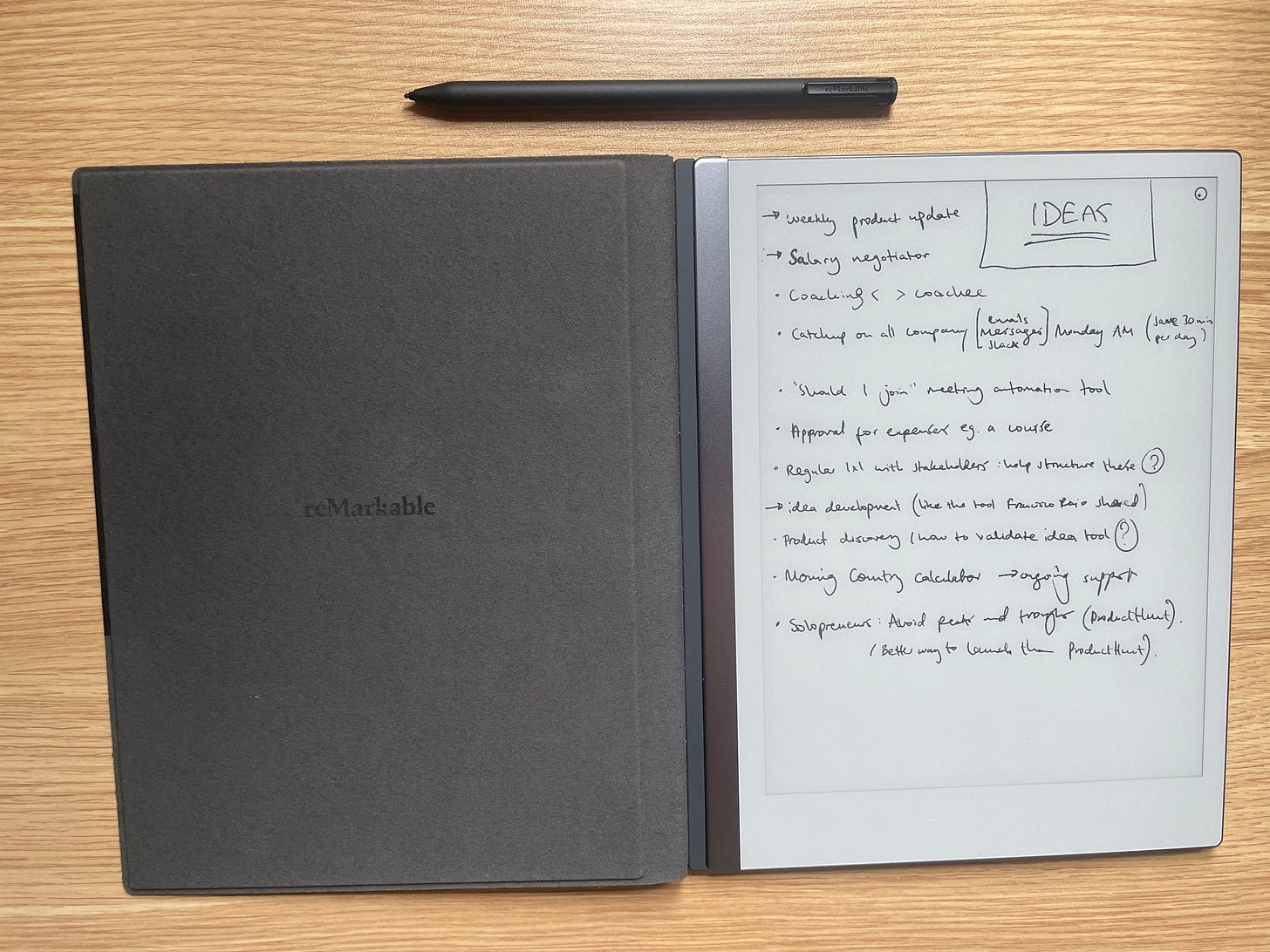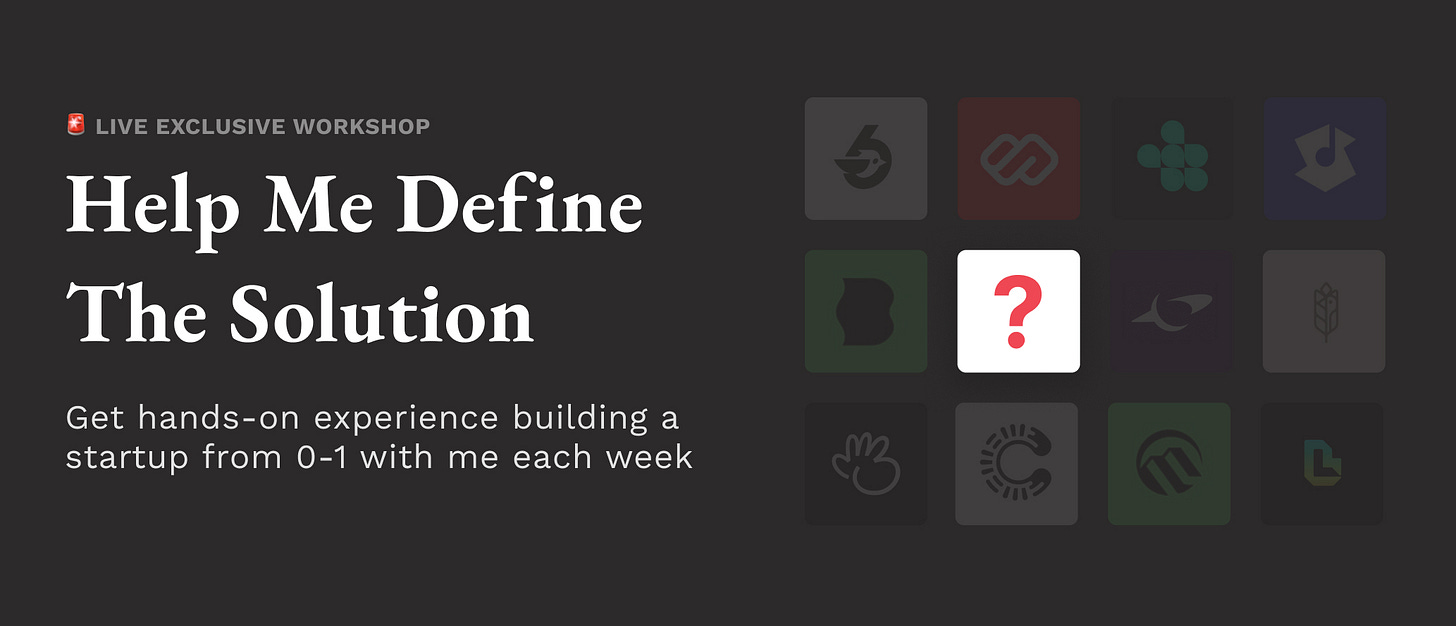Startup #1: What to Build?!
Learn my lightning-fast process for generating & assessing startup ideas
Each week, I’ll share what I’ve been working on. In this edition, I’ll cover:
How I generate startup ideas
How I filter those ideas
What I’m building for Startup #1
1/3 How I Generate Startup Ideas
Let’s talk constraints, then process.
Constraints
Building each SaaS startup is going to come with some unique constraints:
I’m non-technical: I can code a bit but decided against custom code. It would a) take too long to get my first product out & b) likely get stuck on unknown issues
I’m going solo: I need to be really careful how I manage my time (particularly balancing it between building the product & building demand for the product)
Distribution is hard: If I can’t get a product in front of the right audience, the product fails. That’s why, as I outlined last week, I’m going to build these products for you, the reader (hopefully, a ready-made distribution channel!)
I’m self-funding: All 12 products will be paid so I can prove profitability very quickly. This means each product needs to be good enough for the target market to pay for from launch
I’m building using Bubble: This is easier than custom code. BUT, even with low-code, it’s easy to get stuck for days on tough, unknown tech challenges. I’ll therefore try to focus on simple solutions
I’m launching 1 per month: Honestly, that means I’m probably going to launch 1-2 products I’m embarrassed by. Things that lack the V of MVP. But it also forces me to ship. And the more I ship, the higher chance 1-2 products will be a bit success (more on how I define success next week).
Some would see these constraints as a limitation.
I don’t.
I simply see them as a lens to help me filter what I should - & should not - work on.
On that topic…
How do I actually come up with business ideas to assess in the first place?!

My Ideation Process
My process is surprisingly simple:
I come up with a load of potential problems to solve. Some tactics I use:
I think of problems I’ve had in the last 30 days (look at things on my to-do list, my calendar, browse my banking app to see what I’ve spent money on recently, etc.)
I ask friends about their problems
I post on social networks
I see what kind of product categories are trending on Product Hunt (e.g. accounting automation) & Indie Hackers
I define a very specific target market for the product: The more specific, the easier it will be to attract that group & build the right thing for them e.g. Better to build for “1st time Product Managers in Series A startups” than “all product people”

Example from my ideation worksheet I come up with a few possible ways I could solve the problem e.g. If the problem is “creating product updates takes me hours each week”, I could build a “product update AI assistant”, a “platform for creating & storing these updates”, or maybe even address the root problem here of “a tool to help you stand out to your boss”. There are always way more ways of solving a problem than we at first think

2/3 How I Filter My Ideas
At this stage, I’ve got 10+ solutions I could build. Now it’s time to stress-test those ideas. To do that, I will filter out ideas that don’t hit 5/7 of the following criteria:
🚑 Is it solving an acute problem?
If so, the target customer is much more motivated to check out your offer, try it out, and ultimately, pay for it.
(This is why I sent out the survey above last week: to get a sense of which problems were more acute)
🌍 Is the market addressable?
If I can’t find the target market and consistently get my offer in front of them, I will get zero customers.
🔍 Have I gone niche enough?
I want to dig 3 levels down to make this product super specific to that specific audience. Don’t build something for “all product people”. Build for “1st time Product Managers in Series A startups in London”. You’ll do a better job of attracting your audience and building a valuable product for them.
🔥 Does it excite me?
If not, I’ll probably give up (or just do a half-baked job of working on it!). Doesn’t matter how great the idea is on paper.
💰 Is this a good market?
Does this niche tend to spend money solving this problem?
Can I see a gap for a differentiated offer?
Does there seem to be frustration with the existing solutions here?
💡 Can I think of a simple solution to build?
I’m working alone. I’m not a developer. I have limited resources. I need to focus on what is realistic. However, even if I had a massive, well-funded team, I would still ask this question. ALWAYS start small and simple. Create some value quickly, then iterate.
📢 Is there potential for word-of-mouth?
In-built virality is faster, more effective, and cheaper than any marketing initiative will ever be.

Once I select a solution I see potential in, there are still two more steps before I commit to an idea:
Work out whether it could be profitable
Define a compelling offer to pitch the solution effectively
(But I’ll talk about the two frameworks I use for that in next week’s newsletter.)
3/3 What I’m Building For Startup #1
From my problem ideation exercise, I see 5-6 high-potential startup ideas I could choose from.
However, for my 1st startup, I've decided to also factor in the following:
Setting up the architecture for my 1st solution will take a lot more time than solution 2-12. I need to create all the reusable logic (landing page, signup, accept payment, etc.) from scratch. That means less time for working on new features
I also haven’t used low-code or code for 2 years, so there’s a learning curve. I’ll likely get stuck on a few unknowns
I’ve also got less time in July & August, as I’m looking after my son in the afternoons
I really want to launch Startup #1 within 30 days (by ~4th August) to give me momentum for the rest of the year
I’m therefore building what I believe is the startup with the least uncertainty.
One where I’m confident the problem is acute & addressable - & that I can solve with a simple solution.
That’s why I’ve decided to build TLDR Product Update to start, solving the problem for Product Managers who spend hours each week writing weekly product updates.
HOWEVER, I need your help defining the exact solution.
How, specifically, should I solve this?
I have some ideas, but I want your help to design what the specific solution should be (user goals, flows, wireframes, etc.).
How?
Join me in a live, interactive workshop next Wednesday 5-5.45pm (UK) to do just that 👇

That’s it for Week 1!
📣 P.S. Reply to this email, comment below or message me on LinkedIn with any ideas or feedback.
Also, Thanks to Dan Course for suggesting a live stream (more on this next week) & to Rob, Melzer, David, Claudio & Soodesh for proof-reading this newsletter 🙏
Henry
Next Week I’ll Be Sharing…
The business model for TLDR Product Update (Startup #1)
How I define success for each startup
Results from the solution workshop





Cant wait to see how this first startup progresses. :)